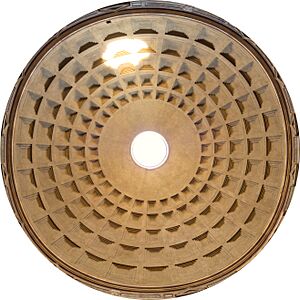Oculus facts for kids
An Oculus is a Latin word that means "eye". It's a round opening or window, often found in the center of a dome or in a wall. The most famous oculus is the large hole in the ceiling of the Pantheon in Rome.
Contents
What is an Oculus?
An oculus is basically a circular opening. It can be a window, a skylight, or even a design element. Architects have used oculi for thousands of years. They let in light and sometimes fresh air. They also add a beautiful, unique look to buildings.
Famous Oculi in History
Oculi have been a part of architecture for a very long time. Ancient civilizations used them in their temples and public buildings. They are a simple yet powerful way to connect the inside of a building with the sky.
The Pantheon's Amazing Eye
The oculus in the Pantheon in Rome is one of the most famous examples. It's the only source of light for the huge building. Rain and light come through this open "eye" in the dome. The floor below has drains to handle any rain that enters. This oculus shows how clever ancient Roman engineers were. It's a truly amazing sight!
Oculi in Different Buildings
You can find oculi in many different styles of architecture. From ancient Roman buildings to Islamic mosques and Gothic cathedrals, oculi appear everywhere. They can be simple holes or decorated with fancy designs. They are a timeless feature that adds beauty and function to buildings around the world. Look at the images below to see some examples!
Images for kids
-
Romanesque oculus of the Église Sainte-Anne de Gassicourt (Mantes-la-Jolie, France)
-
Gothic oculus in the Laon Cathedral (Laon, France)
-
Renaissance oculus of the Florence Cathedral (Florence, Italy)
-
Baroque oculus in a dome of the Ravenna Cathedral (Ravenna, Italy)
-
Rococo oculus in the Parc de Bagatelle (Paris)
-
Louis XVI round window of the Petit Trianon (Versailles, France), with a festoon-derived ornament at the top
-
Gothic Revival oculus of the Hannoversche Bank - Haus III on Georgstraße (Hannover, Germany)
-
19th century Eclectic Classicist oculus of the Opéra-Théâtre de Clermont-Ferrand (Clermont-Ferrand, France)













